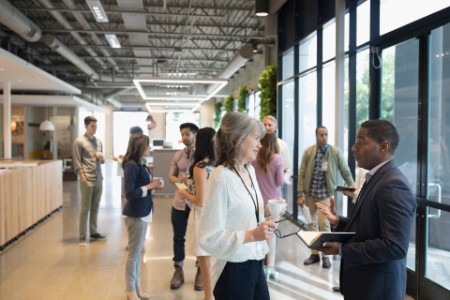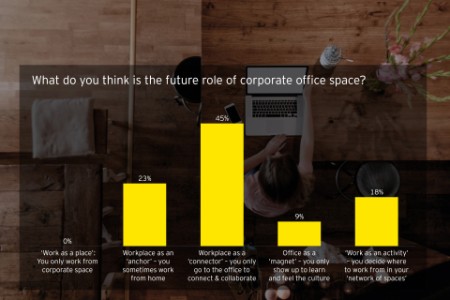The new technology gap
New technology like sensors and apps are already being used to support finding colleagues, space and book services. However, there is still a huge gap in connecting many separate solutions with data from workplaces so workers can make more informed choices. Businesses need to develop the technology behind dynamic planning tools that will support, for example, arranging a meeting with short notice, considering where colleagues are at the moment, and where they prefer to be physically, and matching everything with available workplace resources.
The sustainable workplace
In many organizations, “bricks”’ is often the second or third largest cost category (competing with salaries and IT costs). If employees can work remotely over the long term, it will allow some organizations to make a significant reduction in the need for corporate real estate, even considering future increased social distancing.
The shift is further accelerated by the fact that office buildings are one of the key direct emission sources impacting the carbon footprint and other emissions for many companies. Decarbonization is identified as one of eight 2020 megatrends identified by EY that will shape the world now, next and beyond. To decrease the required office space and related carbon emissions only underlines the need for organizations to explore hybrid working models. Data and technology will be a huge driver in executing this.
According to our declaration of being carbon negative in 2021 and net zero in 2025, EY has reduced its real estate occupancy from 13.8m² per person to 7.6m² per person globally. By avoiding the use of 1.9m m² of space over the last decade, EY drove down its emissions to over 150k tCO2e, which translates to an annual energy use of 17,830 houses or 380 million miles driven by average passenger vehicles.
At the “Head of Workplace Roundtable” hosted by EY for 39 large organizations in the Nordics across varied sectors such as finance, automotive, pharmaceutical and utilities, nearly 90% said they would prioritize sustainability as “high” or “very high.” Organizations are likely to invest much more in resizing and redesigning their workplaces to support better hybrid working and improve workplace and people experiences. Organizations and EY teams are already starting initiatives like “power-positive and carbon-negative” buildings, urban farming, sustainable behaviors and CO2 tracking connected to individual behavior.
The inclusive workplace experience
During COVID-19, many workers experienced more inclusive meetings, with everyone being on the same platform and taking up the same virtual space. Many also experienced a more human touch to corporate life, getting glimpses of not before seen private life aspects. We can also see from Microsoft analytics data, that across organizations internal networks are becoming more siloed, and that the outer networks are shrinking. A surprisingly high ratio of employees does not have 1:1 time with their closest managers at all (Head of Workplace Roundtable). We see that the (male) leaders in general are thriving much better than the single (mom) and new employees (Microsoft research).
Most modern organizations are taking the diversity and inclusiveness agenda to the board level together with sustainability. The workplace inclusiveness agenda is not only about gender, it is also “just” about how majorities and minorities are interacting, to what degree they are allowed to appear at all, and how individuals are making sense of it all and feeling that it is OK to decide how to work for themselves or not.
Even before COVID-19, it was already challenging to participate in hybrid meetings, where the majority was often physically in a meeting room and a minority or maybe just one person was calling in and maybe not even visually present. There was the informal pre-meeting in the physical room without the remote minority being present at all. During the meeting, the remote minority had the challenge of getting a word in and following the oral conversation and body language in the room. After the meeting, the virtual minority did not participate in the informal physical after-meeting.
Some organizations, even before COVID-19, decided not to have hybrid meetings at all. This is not to suggest this be “the” solution for all organizations post-COVID-19. Rather it is a great example of how we recommend all organizations think through what desired work behaviors they would like to take place in their organization, and then design bricks and bytes in an integrated way to support them. If you then choose to allow for hybrid meetings for good reasons, you need to install hybrid meeting rooms, where the physical layout and workplace technology supports inclusiveness, and maybe consider hybrid meeting guidelines and moderator roles to support — so that everyone feels included, regardless of how and where they choose to work. Inclusiveness is unarguably the best path to pursue, and with evidence strongly suggesting that when employees feel included and have strong workplace networks, they are more innovative and productive (Microsoft research), the question left is “how” to make this happen.
How EY teams can help
EY is the leading advisor in the Nordics for the evolving workplace of the future, including physical workspace. We are uniquely positioned at collaborating with the three domains — HR, IT and FM (facility management), successfully bringing them all onboard in large organizations.
We not only bring deep subject-matter knowledge to the three domains: bricks, bytes, behaviors, but we have also developed a unique approach to combine data about user preferences and perception with objective virtual working behavioral data. This provides businesses a data-based approach while analyzing how they would envision to work in the future. With workplace and people experience at the top of every organizational agenda, employees, too, are invited to participate in the dialogue to arrive at a solution that fits all.
Due to the increased drive toward sustainability globally, leaders today are recognizing the importance of redesigning the physical workplace. It is only through adequate digital tools, new partnership models and the right tone at the top that we can successfully reimagine the workplace of the future and become a modern employer. Bricks, thus, cannot work in isolation. The three Bs must work in tandem to successfully redesign a new era of work.




